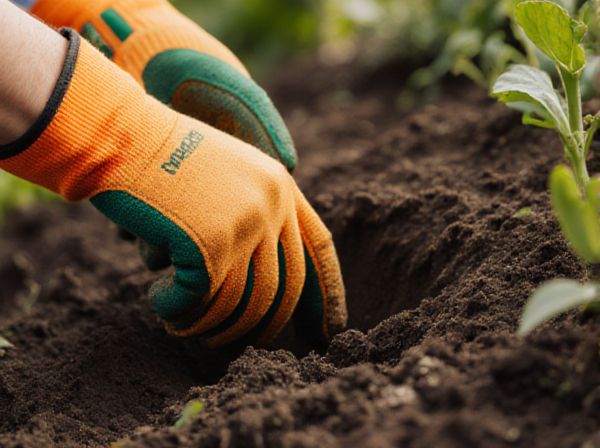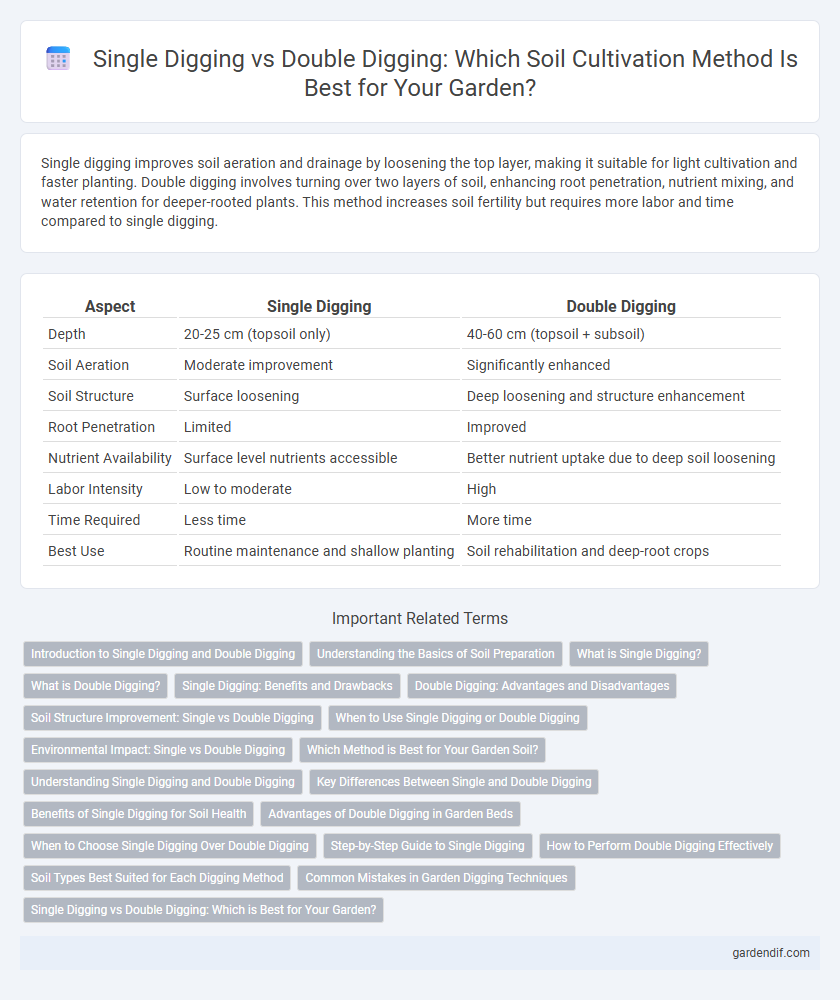
Single digging vs Double digging Illustration
Single digging improves soil aeration and drainage by loosening the top layer, making it suitable for light cultivation and faster planting. Double digging involves turning over two layers of soil, enhancing root penetration, nutrient mixing, and water retention for deeper-rooted plants. This method increases soil fertility but requires more labor and time compared to single digging.
Table of Comparison
| Aspect | Single Digging | Double Digging |
|---|---|---|
| Depth | 20-25 cm (topsoil only) | 40-60 cm (topsoil + subsoil) |
| Soil Aeration | Moderate improvement | Significantly enhanced |
| Soil Structure | Surface loosening | Deep loosening and structure enhancement |
| Root Penetration | Limited | Improved |
| Nutrient Availability | Surface level nutrients accessible | Better nutrient uptake due to deep soil loosening |
| Labor Intensity | Low to moderate | High |
| Time Required | Less time | More time |
| Best Use | Routine maintenance and shallow planting | Soil rehabilitation and deep-root crops |
Introduction to Single Digging and Double Digging
Single digging involves loosening the topsoil to a depth of one spade (approximately 20-25 cm), improving soil aeration and root penetration with less labor. Double digging extends this process by also loosening the subsoil another spade's depth beneath the surface layer, significantly enhancing drainage and nutrient availability for deep-rooted plants. Both techniques optimize soil structure but vary in intensity and suitability depending on soil type and garden requirements.
Understanding the Basics of Soil Preparation
Single digging involves turning the soil to a depth of about 20-30 cm, which helps to aerate the soil and mix in organic matter for improved fertility and root penetration. Double digging goes deeper, around 45-60 cm, breaking up compacted layers and enhancing drainage, which promotes better root development and soil structure. Proper soil preparation through single or double digging influences nutrient availability, moisture retention, and overall plant health.
What is Single Digging?
Single digging refers to the process of loosening and turning over the top 6 to 8 inches of soil using a spade or fork, aiming to improve soil aeration and drainage. This method removes weeds and incorporates organic matter, enhancing soil structure and fertility without disturbing deeper layers. Single digging is ideal for routine garden maintenance and preparing soil for planting shallow-rooted crops.
What is Double Digging?
Double digging is a deep soil cultivation technique that involves loosening two layers of soil to improve aeration, drainage, and root penetration. This method typically requires removing the top layer of soil, loosening the underlying layer with a fork, and then mixing organic matter into the soil. Double digging promotes healthier plant growth by enhancing soil structure and nutrient availability compared to single digging.
Single Digging: Benefits and Drawbacks
Single digging enhances soil aeration and drainage while reducing labor and time compared to double digging, making it suitable for less compacted soils. It preserves soil structure by disturbing fewer microorganisms and maintaining organic matter layers, which supports beneficial soil biology. However, single digging may not sufficiently alleviate deep compaction or improve subsoil conditions, limiting root penetration in heavy or clay-rich soils.
Double Digging: Advantages and Disadvantages
Double digging enhances soil aeration and drainage by loosening deeper layers, promoting robust root growth and improved nutrient absorption in garden beds. This method increases soil fertility through better organic matter integration but requires significantly more labor and time compared to single digging. Overdisturbance may disrupt soil structure and microbial life, posing a risk of erosion if not managed properly.
Soil Structure Improvement: Single vs Double Digging
Single digging aerates the soil to a shallow depth, promoting moderate root growth and improved water infiltration in the topsoil. Double digging enhances soil structure more profoundly by loosening multiple layers, increasing aeration, drainage, and nutrient availability for deep-rooted plants. This method significantly boosts microbial activity and soil fertility compared to single digging, resulting in healthier plant development.
When to Use Single Digging or Double Digging
Single digging is ideal for garden beds with relatively loose soil or when minimal disturbance is needed to incorporate organic matter and improve aeration. Double digging suits compacted or heavy clay soils requiring thorough loosening to enhance root penetration, drainage, and nutrient absorption. Choosing between single and double digging depends on soil condition, drainage needs, and the specific crop requirements for optimal growth.
Environmental Impact: Single vs Double Digging
Single digging disturbs the soil less, preserving its natural structure, microbial life, and carbon content, which helps reduce erosion and maintain soil health. Double digging, while enhancing aeration and root penetration, significantly disrupts soil layers and microbial ecosystems, potentially accelerating organic matter decomposition and increasing carbon release into the atmosphere. Choosing single digging over double digging supports sustainable soil management by minimizing environmental impact and promoting long-term soil fertility.
Which Method is Best for Your Garden Soil?
Single digging improves soil aeration and drainage by loosening the top 20-25 cm, making it suitable for most gardens with minimal disturbance. Double digging penetrates deeper, around 40-60 cm, effectively breaking up compacted layers and enhancing root growth in heavy clay or poor-quality soil. Choosing the best method depends on your soil type and plant needs: single digging for regular maintenance and double digging for initial soil improvement or challenging soil conditions.
Single digging vs Double digging Infographic

 gardendif.com
gardendif.com